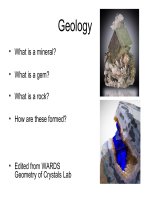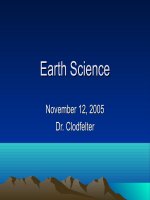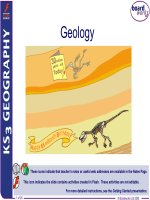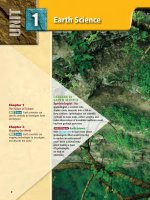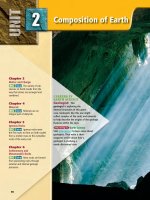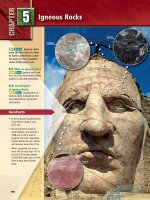Earth science geology
Bạn đang xem bản rút gọn của tài liệu. Xem và tải ngay bản đầy đủ của tài liệu tại đây (7.35 MB, 69 trang )
Earth Science
November 12, 2005
Dr. Clodfelter
The Geologic Time Scale
The history of the
Earth is broken up
into a hierarchical set
of divisions for
describing geologic
time
The Geologic Time Scale, cont.
Highlights of recent fossil finds from
throughout geologic time (from most
ancient to most recent) are:
• Precambrian Era: the first fossil bacteria,
sponges, corals, and algae appear
• Cambrian Period: abundant invertebrate
fossils such as mollusks, crustaceans
The Geologic Time Scale, cont.
• Triassic Period: the first fossils of
primitive dinosaurs appear
• Jurassic Period: the first fossil mammals
and birds; first fossil flowering plants
appear
• Cretaceous Period: large fossil dinosaurs
appear
Quaternary
Tertiary
Cretaceous
Jurassic
Triassic
Permian
Carboniferous
Devonian
Silurian
Ordovician
Cambrian
Precambrian
Precambrian Eon
4.5 Billion to 543 Million Years Ago
• Nearly 4 thousand
million years after the
Earth began
• The first animals left
their traces
• Makes up roughly 7/8
of the Earth's history
Archaean Era
3.8 to 2.5 Billion Years Ago
• The atmosphere was very different from
what we breathe today
• The Earth's crust cooled enough that
rocks and continental plates began to form
• Life first appeared on Earth
– bacteria microfossils
Phanerozoic Eon
543 Million to
• Majority of macroscopic
organisms, fungal, plant
and animals lived
• Appearance of animals
that evolved external
skeletons – like shells –
and animals that formed
internal skeletons – like
vertebrates
Paleozoic Era
543 to 248 Million Years Ago
• In the beginning, multicelled animals
underwent a dramatic "explosion" in
diversity
• At the end, the largest mass extinction in
history wiped out approximately 90% of all
marine animal species
Paleozoic Era
543 to 248 Million Years Ago
Mesozoic Era
248 to 65 Million Years Ago
•
•
•
•
•
Mesozoic means "middle animals”
Lasted 70 Million Years
Time of transition
The world-continent of Pangaea existed
The time in which life as it now exists on
Earth came together
• Important today because of the fossils and
oil left behind
Mesozoic Era
248 to 65 Million Years Ago
Divided into three time
periods:
– the Triassic (245208 Million Years Ago)
– the Jurassic (208146 Million Years Ago)
– the Cretaceous
(146-65 Million Years
Ago)
Dinosaurs in the Mesozoic Era
Dinosaurs...
– Evolved in the Triassic Period
– Became more diversified in the Jurassic
Period
– Became extinct in the late Cretaceous Period
– Fossils of some of the last dinosaurs to walk
the Earth can be found in Montana
The Cretaceous/Tertiary
Boundary in Montana
Cenozoic Era
• The most recent of
the three major
subdivisions of animal
history
– The other two are the
Paleozoic and the
Mesozoic
• Spans only about 65
million years
• Sometimes called the
“Age of Mammals”
A Continental Jigsaw Puzzle:
Putting the Pieces Together
•
•
•
•
1911
German meteorologist
Alfred Wegener
theorized that about 300
million years ago all the
continents we know today
were joined together in a
single continent
• he named it “Pangaea”
(pronounced Pan JEE uh)
A Continental Jigsaw Puzzle:
Putting the Pieces Together, cont.
• Wegener suggested that Pangaea split
apart and its pieces began to “drift,” or
move away from each other
• He put together his own evidence, as well
as others’, to support his Theory of
Continental Drift
A Continental Jigsaw Puzzle:
Putting the Pieces Together, cont.
• At first, Wegener’s ideas were very popular
because his evidence seemed quite convincing
• Yet a number of observations still remained
unexplained
– What forces caused the continents to move?
• Due to these remaining problems, Wegener’s
theory rapidly lost support and continental drift
became “just another theory”
What are Crustal Plates?
• Earth’s crust isn’t one continuous surface
like the skin of an orange
• It is made up of gigantic pieces, like
pieces of a jigsaw puzzle
• Each piece is called a crustal plate
• Some plates form the floor of the oceans
while other carry the continents
Crustal Plates
• Molten rock around the Earth’s core heats
up the mantle above
• Currents of molten rock rise up through
the mantle like boiling water
• As each current hits the underneath of the
crustal plates, it starts to spread out
• This slowly pushes or tears the crust apart
Crustal Plates
• The plates are always on the move
• There are three basic types of plate
boundaries
– where they are sliding past each other
– where plates are separating
– where they are converging (approaching
each other)
Crustal Plates
• Spreading Center - the boundary between
separating plates
– Usually found in mid-ocean and are marked by
rugged mountain chains called mid-ocean ridges
• As plates move apart a gap continuously opens
between them
• Molten rock from the earth’s interior flows into
this gap
– New crust is continuously formed
Plates and Sea Floor Spreading

